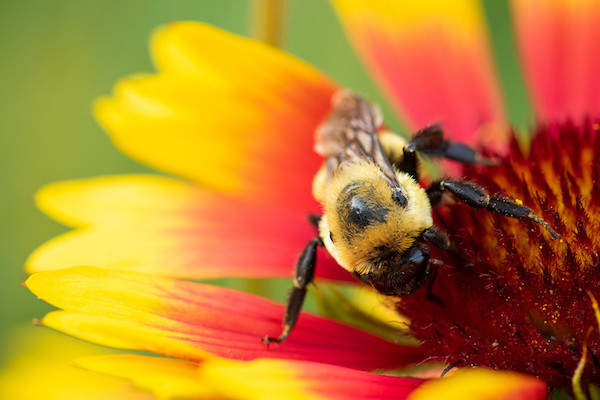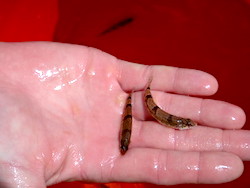SEJournal Online is the digital news magazine of the Society of Environmental Journalists. Learn more about SEJournal Online, including submission, subscription and advertising information.
 |
 |
| Plummeting populations of the American bumblebee is but one example of local biodiversity stories. Above, a bumblebee on an Indian Blanket flower in a wildflower pollinator meadow in Idaho. Photo: USDA/Kirsten Strough via Flickr Creative Commons (Public Domain Mark 1.0). |
TipSheet: Could Biodiversity Be Bee’s Knees for Environmental Journalists This Fall?
By Joseph A. Davis
Biodiversity will be in the news this fall, in large part when a big U.N. conference meets in Montreal Dec. 7–19. Yes, it’s a critical worldwide issue. But have you looked into the local biodiversity concerns near you?
A bit of background: The Montreal meeting is a conference of parties — COP15, to be exact — to the U.N. Convention on Biological Diversity. The convention was signed (as was the U.N. climate treaty) at the historic 1992 Earth Summit in Rio de Janeiro. There will be enough drama there, because expectations are high and agreement has been elusive.
But it’s worth remembering that people in the U.S. have been fighting about biodiversity even longer, since at least 1973, when the Endangered Species Act, or ESA, was passed. In fact, you can trace efforts to preserve wildlife in this country back to at least 1903, when President Theodore Roosevelt established the first federal wildlife refuge. But that’s a long story for another time.
The main point: Wherever you (and your audience) are, you can be sure there are some local biodiversity stories — and that they are controversial. It’s a good time to look at where they stand.
Why it matters
The Earth’s biodiversity is what allows humans to survive. Yes, plants and animals give us food, and have done so for millions of years. Only more recently have we begun to understand how many species and environments are interdependently connected in ecological webs. And, the scientists tell us, biodiversity is a sign and foundation of a healthy, sustainable ecosystem.
Relatively undisturbed habitat is one
thing that allows healthy and biodiverse
ecosystems to flourish. Unfortunately,
we have disturbed a lot of habitat.
Habitat that is relatively undisturbed by humans is one thing that allows healthy and biodiverse ecosystems to flourish. Unfortunately, we have disturbed a lot of habitat, through agriculture, logging, urban development and more.
It would not be accurate to say that North America was untouched in 1492. There had been Native people here for millennia, and they had managed the land in ways that were usually biodiversity-friendly.
But when Europeans (and others) settled the continent, things changed. Trappers harvested as many pelts as they could. Land was logged, farmed and grazed. Extractive industries like mining left huge scars, holes and other messes. And even today, ranchers shoot wolves that prey on livestock.
At the same time, there are many schemes around the world for preserving or protecting habitat (both on land and in water). In the United States alone, there are numerous conservation designations for many purposes, and each of them has different laws and rules.
For instance, there is a lot of semi-wild open rangeland, mostly managed by the Bureau of Land Management. There are more: National forests, wilderness, parks and park system units, wildlife refuges, grasslands and monuments, to name some of the bigger ones. There are often analogous designations at state and local levels. And there are also wild and scenic rivers and national marine sanctuaries. It doesn’t end there.
The backstory
It’s worth considering the tale of the Tellico Dam in Tennessee. It was one of the biggest environmental stories of the 1970s. This Tennessee Valley Authority project had been conceived as early as the 1930s, but began construction in 1967, continuing into the 1970s (remember the ESA passed in 1973).
 |
| The tiny snail darter fish, pictured above, was at the heart of a seminal endangered species dispute in the 1970s. Photo: Fishes of Georgia Photo Gallery/Brett Albanese(Georgia DNR–Wildlife Resources) via Flickr Creative Commons (CC BY NC-ND 2.0). |
The dam was meant not for flood control or hydropower but to promote tourism and housing development in a poor area. Families in the reservoir were upset when their land was taken by eminent domain. Local opponents then teamed up with environmentalists, who opposed it on other grounds (citing, for instance, the 1970 National Environmental Protection Act, and later on using the ESA).
The case in point was the habitat of a tiny, obscure and endangered fish called the snail darter. The argument was that building the dam would wipe out the species. The resulting lawsuit went all the way to the Supreme Court, which backed environmentalists (it was another era). But Congress later overrode the court decision, and the dam was built. Today, snail darters are still around.
But the Tellico case might be an object lesson for journalists. Sometimes conservationists justifiably and honestly are trying to protect a species (and many sincerely believe that all species should be saved). On the other hand, endangered species may sometimes be a powerful and convincing argument used by people who would oppose a project anyway — the NIMBY syndrome (Not In My Back Yard). Give your audience the information they need to figure that out.
Story ideas
- What species have been spotlighted as endangered near you? What protections do they need to recover?
- What state agencies have responsibility for fish and wildlife conservation near you? What agencies manage mining, agriculture, highways and water development? How do they mesh or conflict?
- Does your state have its own fish and wildlife conservation law? How well is it enforced? Where is it enforced?
- Ask state and local groups what lawsuits are going on in your area that impact biodiversity. Ask litigation groups like the Center for Biological Diversity (more below) or Earthjustice what lawsuits they know of that involve your area.
- Talk to local birding or stream cleanup groups (e.g., Waterkeeper) about what they are observing and what concerns them.
Reporting resources
- U.S. Fish and Wildlife Service: This federal agency has major responsibility for carrying out the Endangered Species Act.
- U.S. Forest Service: Responsible for national forests, its mission ranges from wilderness protection to logging and grazing, under specific laws.
- Center for Biological Diversity: A nonprofit advocacy group that litigates and lobbies.
- The Wilderness Society: Advocates for keeping federal lands wild, especially in national forests.
- World Wildlife Fund: A U.S.-based international group that advocates for endangered species conservation, with emphasis on protecting habitat.
- International Union for Conservation of Nature: An expert conservation group with global reach. Publishes an annually updated “red list.”
- Property and Environment Research Center: A think tank that works for “free market environmentalism.”
- Local Conservation Groups: These will vary by region and locality. They will be keyed in on the problems of species nearby. Look also for national groups like the Sierra Club that have local chapters.
[Editor’s Note: For more on localizing biodiversity stories, see an earlier Tipsheet on how pollinator gardens yield local story possibilities, a Backgrounder on planning stories around our nation’s green spaces and a BookShelf review of a recent volume on saving the U.S.’s most biodiverse river system. Also, get the latest headlines and stories on biodiversity and wildlife from our Topics on the Beat pages.]
Joseph A. Davis is a freelance writer/editor in Washington, D.C. who has been writing about the environment since 1976. He writes SEJournal Online's TipSheet, Reporter's Toolbox and Issue Backgrounder, and curates SEJ's weekday news headlines service EJToday and @EJTodayNews. Davis also directs SEJ's Freedom of Information Project and writes the WatchDog opinion column.
* From the weekly news magazine SEJournal Online, Vol. 7, No. 39. Content from each new issue of SEJournal Online is available to the public via the SEJournal Online main page. Subscribe to the e-newsletter here. And see past issues of the SEJournal archived here.












 Advertisement
Advertisement 



